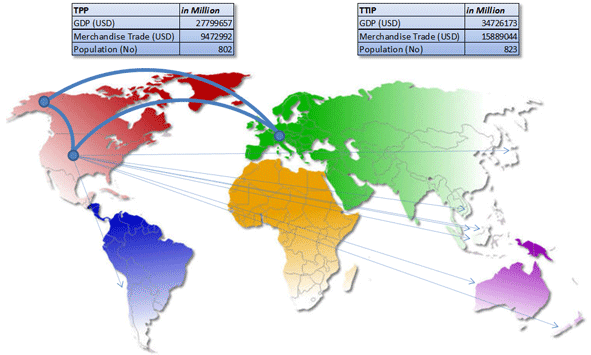

PMMAI earned recognition as an industry association of national status representing the interest of Plastics Machinery manufacturing sector of our country with the Department of Heavy Industries, Ministry of Commerce, Ministry of Finance & Revenue, Department of Chemicals & Petrochemicals.
Global trade environment and Regional Comprehensive Partnership Agreement (RCEP)
Global trade scenarios are fast changing, as major economies are moving towards larger integration via Mega trade agreements instead of small bilateral agreements with handful of other economies.
Two mega trade agreements Trans Pacific Partnership (TPP) and Transatlantic Trade & Investment Partnership (TTIP) promise to integrate West, East and South East Asia. TPP, being negotiated between Australia, Brunei, Canada, Chile, Japan, Malaysia, Mexico, New Zealand, Peru, Singapore, the United States and Vietnam- intends to “enhance trade and investment among the TPP partner countries, to promote innovation, economic growth and development, and to support the creation and retention of jobs”. TTIP, being negotiated between the European Union and the United states aims at multilateral economic growth. Both these agreements are believed to have the potential of setting member economies feet more into global value chain. TPP and TTIP formation together commands around 20- 22% of world population, but accounts for more than 35% and more than 50% of World GDP, respectively.

These trade engagements between major economies have the potential of adversely affecting non- TPP and TTIP member countries like India. It became a cause of concern for India, as India was not a participating member of TPP and TTIP, and had limited trade agreements unlike other major economies by then. India though had been negotiating India- EU BTIA, subduing the effect of its non- participation in TTIP - India had no or limited preferential trade engagement with the US and other participating countries in TPP. And therefore, it was imperative for India to participate in Regional Comprehensive Partnership Agreement (RCEP). However, vital difference between TPP and RCEP is participation of China in RCEP, but not in TPP. TPP could have given India similar edge as RCEP.
Integration into global value chain is important given fast changing global trade scenarios. Trade agreements are for the same purpose, precisely. Signing such mega trade agreements has certain temporary disadvantages, but permanent advantages in long run. Minimum temporary damage to domestic industry and maximum benefits in near/ far future to economy can only be ensured by timely inputs by stake holders/ interested parties during negotiations and critical analysis of the adverse effects by the Government. RCEP is into similar debate- how to minimize adverse effect and ensure maximum benefits?
It is evident that India’s participation in RCEP could not have been ruled out. So, whole heartedly accept India’s participation in RCEP, and prepare for smooth integration with diverse economies. This calls for not only engaging into negotiations from agreement perspective- but attempting to align domestic policies and foreign trade policies with this and other agreements under negotiation. Therefore, with global integration, it is equally important to align trade agreements with domestic and foreign policies to the extent possible.
RCEP negotiations between 10 ASEAN countries, India, China, Japan, South Korea, Australia and New Zealand which aims at integrating member countries into the global market through regional economic integration, leading to the largest regional trading bloc in the world commanding almost 45% of the world population with a combined GDP of around USD 21 trillion, is an ambitious partnership. India’s participation in RCEP- to certain extent would secure its position with respect to changing global environment. However, certainly, minor to major reforms in domestic and foreign policies will have to be made for outspreading reach into Global value chain with minimal adverse effect to domestic established strength and realized potential.
India has significant trade with all RCEP member countries, which is around 26% of its total trade with the World. Currently, India has trade deficit with all RCEP member countries. Its total trade with each of these countries is as in Table 1.
| Model | Indicative SPVC Kg/Hr(Output Filled) | Indicative SPVC Kg/Hr(Output Unfilled) |
|---|---|---|
| 2–65–2V | 150–250 | 140-190 |
| 2–68–28 V | 200–350 | 190-250 |
| 2–92–28 V | 450-700 | 450-550 |